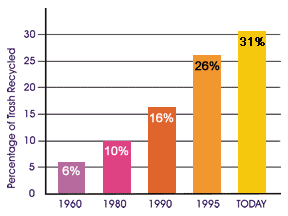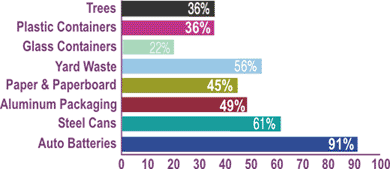|
|
||||||||||||
|
|
||||||||||||
What is Recycling?
Where to Recycle
Recycling - Keys to Success
Deciding When to Recycle
Recycling Guide
 Recycling
means to use something again. Newspapers can be used to make new newspapers.
Aluminum cans can be used to make new aluminum cans. Glass jars can be used
to make new glass jars. Let’s take a look at some of the benefits of recycling.
Recycling
means to use something again. Newspapers can be used to make new newspapers.
Aluminum cans can be used to make new aluminum cans. Glass jars can be used
to make new glass jars. Let’s take a look at some of the benefits of recycling.
| CLOSED LOOP RECYCLING |

Closed loop recycling is making an old product into the same thing again. It means turning old aluminum cans into new aluminum cans, or old glass jars into new glass jars. |
|
Turning plastic milk jugs into flowerpots is not closed loop recycling
because a different product is made. |
| Closed loop recycling is ideal because there is already a market for the
recycled product; manufacturers don’t have to hope that people will buy
aluminum cans, they know people will. That may not be true for recycled
plastic flowerpots, though. |
Recycling Can Reduce the Cost of Waste Disposal.
Getting rid of trash isn’t a free proposition. Garbage trucks must pay to dump
their waste at a landfill. The payment is called a tipping fee, and it is based
on the weight or volume of the garbage. Tipping fees vary in different areas. In Vermont, one landfill charges about $65 a ton
for the waste it receives. Recycling reduces landfill costs because less waste
is landfilled. In 2003, recycling and composting diverted 72 million tons of material from landfills.
Recycling Can Save Energy.
It almost always takes less energy to make a product from recycled materials
than it does to make it from new materials. Using recycled aluminum scrap to
make new aluminum cans, for example, uses 95 percent less energy than making
aluminum cans from bauxite ore, the raw material used to make aluminum. One
exception to the recycling-saves-energy rule is plastics. Sometimes it takes
more energy to recycle plastics than it does to use all new materials.
Recycling Saves Natural Resources.
Natural resources are riches provided courtesy of Mother Nature. Natural resources
include land, plants, minerals, and water. By using materials more than once,
we conserve natural resources. In the case of paper, recycling saves trees and
water. Making a ton of paper from recycled stock saves up to 17 trees and uses
50 percent less water.
Recycling Can Reduce Air and Water Pollution.
Using aluminum scrap instead of bauxite ore to make new aluminum products cuts
air and water pollution by 95 percent. If you want to do something for the environment,
recycle those aluminum cans!
Recycling Creates Jobs.
Recycling is estimated to create almost five times as many jobs as waste disposal. Recycling requires businesses that collect, haul, and process recyclables, as well as businesses that manufacture products from recycled materials. People employed in the recycling industry may be material sorters, truck drivers, sales representatives, process, engineers, or chemists. The National Recycling Coalition reports that recycling supports 1.1 million jobs in the U.S.
Many people think the United States should recycle more of its waste. Even the experts disagree on the best way to go about it. Should communities pick up residents’ recyclables? Or is this practice too expensive for over-stretched city budgets? Does community recycling deprive the traditional picker-uppers (Boy Scouts, high school groups) of the opportunity to raise money for their clubs? Let’s take a look at some ways recyclables can be collected.
Curbside Collections
Residents leave their recyclables at the curb or in some other designated place
where regular trash is picked up. Communities may require residents to sort
their recyclables—such as aluminum cans, newspapers, and glass—into separate
containers or they may be mingled together. Curbside collection programs boast
the highest recycling rates. Some experts say curbside recycling nationwide
could reduce the volume of solid waste by 15 to 25 percent.
Drop-Off Centers
| RECYCLING fever |

Recycling programs are growing across the United States. The media and
the enviromental movement have focused attention on our mounting waste
problem. Now recycling has become the in thing to do. Americans recycled
just 6 percent in 1960 and 16 percent in 1990, but we recycle about 31
percent today. |
In some areas, people bring their recyclables to collection centers. This saves the community the cost of curbside collection but relies on residents willing to drive to the center for little or no payment. And they usually must crush, sort, and clean them.
Reverse Vending Machines
In many places, there are machines that accept used beverage containers and
reimburse the depositor on the spot. Reverse vending machines are convenient
because they are usually located inside or outside grocery stores.
Deposits
Several states impose a five or 10-cent deposit on returnable bottles and cans.
Consumers get their deposits back when they return the containers to the store
for recycling. These so-called “bottle-bill” states originally passed deposit
laws to combat litter problems. Now they are one step ahead of the game. Deposits
help solid waste disposal problems, too.
Pick-Up by Volunteers
This is recycling the old-fashioned way. Community groups, such as church groups
and the Boy Scouts, collect recyclables to raise money for their clubs. These
groups usually just pick up aluminum and newspapers because their scrap value
is higher than other recyclables.
PROGRAMS
Experts debate whether Americans should be asked to recycle their waste (a voluntary
program), or whether they should be required by law to recycle their waste (a
mandatory program).
Mandatory Recycling
Some communities have passed laws or ordinances mandating that citizens recycle
at least some of their trash. Typically, residents in these communities separate
their newspaper, aluminum, glass, and other recyclables from the rest of their
trash. Other communities may only require that newspapers be separated for recycling.
Residents who do not comply with local recycling laws may be fined, or their
trash may not be picked up. In an effort to encourage recycling, many communities
have adopted pay-as-you-throw programs. Community residents are charged
by the number of trash containers they set out for collection.
In Seattle, Washington, the amount residents pay for garbage pick-up is based on the size of their garbage cans. Usually, the cost of pick-up for one small 12-gallon can is about $10 per month, while the cost for two large 32-gallon cans is almost $33 per month. Residents who are serious about recycling end up paying far less for their garbage disposal.
Voluntary Recycling
Under a voluntary recycling program, residents are encouraged to recycle their
waste, but they are not required to do so. Residents who choose not to recycle
their waste are not fined or penalized in any way. Are mandatory programs better
at recovering recyclables than voluntary programs? The statistics show that
mandatory programs are more successful. In voluntary programs, about one-third
of the community recycles. In mandatory programs, about one-half of the community
recycles. Why don’t more people recycle under mandatory recycling programs?
The answer is simple. Enforcing the laws is impractical. It means going from trashcan to trash can to find out who is recycling. In 2006, Seattle began enforcing its recycling program. Residential garbage cans that contain more than 10 percent recyclables are not emptied, but left at the curb full of garbage. Tags are left on the garbage cans saying why they were not emptied and explaining how to separate out the recyclables for pick-up the following week. Business owners who do not recycle can receive $50 fines.
In any case, new studies suggest that successful recycling programs are those that make it easy for people to recycle. The most successful recycling programs provide residents with special containers for sorting their waste and collect the recyclables weekly along with the rest of the trash. Ease and convenience are the keys to success.
| THINGS WE recycle |

|
Does recycling always makes sense? No, not always. Recycling sounds great, but recycling costs money and uses energy, too. Recyclables have to be collected, sorted, shipped to manufacturing plants, and then made into new products.
Collecting recyclables is only the first part of the story. We can be good citizens and recycle our trash, but if nobody wants to buy the recyclables, we haven’t accomplished much. In other words, somebody has to want to buy old newspapers because it is cheaper to use them to make a new paper product than it is to use virgin paper stock.
What happens when nobody wants to buy recyclables? The East Coast experienced this problem about 15 years ago when there was a glut of old newspapers. Communities on the East Coast collected newspapers for recycling, but nobody wanted to buy them. The newspapers just sat around in warehouses waiting to get a second life.
That is not recycling. Recycling means to make something old into something
new. Collection is only the first step. There is good news for the East Coast,
though. Thanks to consumer demand for recycled paper products, the newspaper
glut has disappeared. Today, many recyclers are eager to get their hands on
as much used paper as possible.
| MATERIAL | CAN be recycled | CAN’T be recycled | HOW TO DO IT |
| GLASS | Jars, bottles Clear, green, amber |
Light bulbs, dishes, Pyrex, crystal |
Rinse, remove lids. Separate by color |
| PAPER | Newspapers, boxes egg cartons, phone books, white office paper |
Waxed, glued, plastic, or foil coated |
Keep clean and dry |
| ALUMINUM | All aluminum—cans pie pans, foil wrap, old windows, lawn furniture |
Rinse and crush | |
| STEEL | Steel (tin) food | Rinse and crush | |
| PLASTICS | All plastics | Check with your recycler | Rinse |
EIA Main Home
Page • Related
Links • Kid's
Page Privacy • Contact
Us